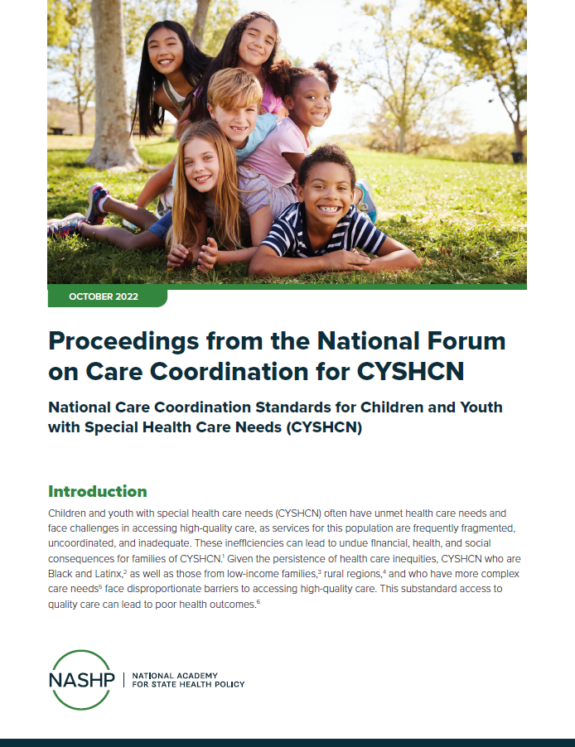Lessons from Medicare on Coordinating Care for Children with Special Health Care Needs
Many children enrolled in Medicaid have special health care needs. Take Tess, for example: she’s 7 years old and has diabetes and a severe speech impairment, and she and her family face a number of daunting challenges. Her primary caregiver is her grandmother, who struggles with health troubles of her own and brings Tess to multiple specialists, a speech therapist, and her primary care physician using public transportation. Her grandmother does her best, but the frequent appointments and demanding treatment regimens for diabetes often leave her overwhelmed. When caregiving becomes too much, she calls on a thin safety net of relatives who need to fit Tess’s care around their own work schedules. Sometimes, Tess has trouble explaining symptoms that might suggest her diabetes isn’t under control. Other times, minor health issues, like high blood sugar during a cold, can balloon out of control and lead to urgent office and emergency room visits, or even hospitalization. These events risk additional complications to Tess’s health, cause her grandmother to miss work and neglect her own health, and are very costly to Tess’s health insurer, Medicaid, and ultimately the public. What can help Tess, her family, and her health care providers work together to address these challenges and ensure that she receives the best care when she needs it?
As researchers, we piece together findings from the best evidence available to answer pressing policy problems and help children like Tess. For a recent study, funded by the Lucile Packard Foundation for Children’s Health and published in the American Journal of Managed Care, we used a novel approach to answer a compelling question: Can we draw lessons from Medicare to improve care coordination for children with special health care needs (CSHCN) – especially those covered by Medicaid?
Public insurance programs, primarily Medicaid, cover about a third of CSHCN (PDF), and Medicaid spending for CSHCN is, on average, six times higher than Medicaid spending for other children (PDF). CSHCN are at risk for emergency care and potentially preventable hospitalizations resulting from poor coordination between their families, members of their health care teams, and other support systems, such as school nurses, afterschool programs, and other community-based programs. For decades, the pediatric community has called for increased care coordination to improve quality and reduce waste in caring for these children. Although there is a growing body of literature on care coordination for CSHCN, studies often lack methodological rigor and vary widely in their underlying conceptual frameworks, making it challenging to draw conclusions about features of effective programs.
In contrast, the literature on care coordination for Medicare populations includes many methodologically rigorous studies. Although CSHCN and elderly Medicare beneficiaries have very different health care and non-health care needs, the goals and design elements of care coordination programs might be similar.
In our study, our team reviewed the evidence on care coordination in Medicare for insights on how to design and implement effective care coordination for CSHCN. We also conducted an environmental scan focused on Medicaid financing and eligibility for care coordination to understand how these insights intersect with Medicaid policy and could be implemented in Medicaid managed care. Importantly, to help us modify and translate the lessons from Medicare and apply them to CSHCN in Medicaid, we also discussed the relevance of the Medicare findings with 11 experts in care coordination for CSHCN from across the country. These included 5 Medicaid medical directors, 3 practicing pediatric clinicians, a former managed care executive, and 2 policy professionals well versed in the research on Medicaid, care coordination, and CSHCN.
Based on our research synthesis and feedback from experts, we identified 6 design elements of care coordination programs that are consistently associated with improved outcomes in Medicare and relevant to CSHCN in Medicaid. They include (1) identifying and targeting high-risk patients, (2) articulating clearly which outcomes programs are likely to improve, (3) encouraging active engagement between care coordinators and primary care providers, (4) requiring some in-person contact between care coordinators and patients, (5) facilitating information sharing among providers, and (6) supplementing care coordinators’ expertise with that of other clinical experts, depending on the medical, social, behavioral, and other needs of the children involved.
State Medicaid policymakers and Medicaid managed care organizations can use some or all of these recommendations to improve care coordination for CSHCN in Medicaid such as Tess, but they should adapt their implementation to suit the unique needs of children and the structure of their state Medicaid programs. An effective Medicaid care coordination program should adjust to the diversity of conditions and medical needs, familial capacity to coordinate care, locally available resources and funding, and social determinants of health among Medicaid-eligible children. Likewise, state Medicaid programs and managed care capitation rates might vary in their ability to support particular programmatic approaches to care coordination. However, the design elements that we identified are evidence based and broadly relevant to CSHCN, and could serve as building blocks for states’ efforts to improve care coordination. In turn, effectively designed care coordination efforts can help Tess’ family—and other families of CSHCN—provide the best care needed for her to thrive.



